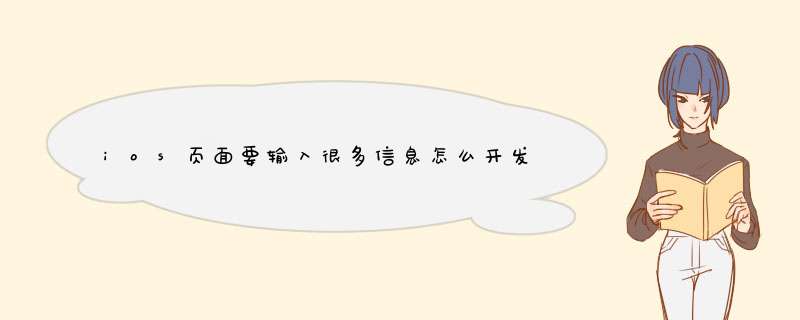
-(void)viewWillAppear:(BOOL)animated
{
[super viewWillAppear:animated]
[self.textField becomeFirstResponder]
}
2、keyboard类型要与想要用户输入的内容匹配:只允许输入数字,则把keyboard类型设为Number;输入邮件地址的则设置为email address field
3、keyboard的return类型应设置合理,需要发送的 *** 作则设置为send,一般完成输入则设置为done
4、当TextField内容为空时,应将keyboard的return(或done或其他)设置为disable
在TextField的Attributes inspector中选中Auto-enable Return Key
5、TextField用keyboard完成输入后按下return(或done或其他),将触发Did End On Exit事件
6、当TextField没有输入内容时,将导航栏上的done按钮隐藏
先将改按钮在Attributes inspector中取消Enable
TextField所在的视图的视图控制器实现协议<UITextFieldDelegate>
添加代码:(doneBarButton为视图控制器的一个outlet属性)
-(BOOL)textField:(UITextField *)textField shouldChangeCharactersInRange:(NSRange)range replacementString:(NSString *)string
{
NSString *newText = [textField.text stringByReplacingCharactersInRange:range withString:string]
self.doneBarButton.enabled = ([newText length] >0)
return YES
}
7、对数据模型的属性,变量等进行修改时,应将其放在数据模型的方法中,然后在视图控制器中调用该方法
8、想让tableview某个cell不被选中,先设置tableview cell的属性selection为None,再添加以下代码:
-(NSIndexPath *)tableView:(UITableView *)tableView willSelectRowAtIndexPath:(NSIndexPath *)indexPath
{
return nil
}
9.如果一个table view cell有两个功能,应添加一个详情按钮,当按下该按钮时,可以查看和编辑,当按下该行其他地方,则触发其他功能(如to-do list中标记某一个cell)。另一种方法则是当点击cell最左边的框框时打上标记,点击该cell其他地方则可以查看和编辑。
10.获取app沙盒Document文件夹路径(用于保存信息):
-(NSString *)documentDirectory
{
NSArray *paths = NSSearchPathForDirectoriesInDomains(NSDocumentDirectory, NSUserDomainMask, YES)
NSString *documentsDirectory = [paths firstObject]
return documentsDirectory
}
11."unrecognized selector"错误一般是没有实现对应的方法导致的
12.自定义初始化init方法格式:
- (id)init {
if ((self = [super init])) {
// Initialization code here.Usually giving properties and instance variables their initial values
}
return self
}
iOS 越来越人性化了,用户可以在设置-通用-辅助功能中动态调整字体大小了。你会发现所有 iOS 自带的APP的字体大小都变了,可惜我们开发的第三方APP依然是以前的字体。在 iOS 7 之后我们可以用 UIFont 的preferredFontForTextStyle: 类方法来指定一个样式,并让字体大小符合用户设定的字体大小。目前可供选择的有六种样式:UIFontTextStyleHeadline UIFontTextStyleBody UIFontTextStyleSubheadline UIFontTextStyleFootnote UIFontTextStyleCaption1 UIFontTextStyleCaption2
iOS会根据样式的用途来合理调整字体。
问题来了,诸如字体大小这种“动态类型”,我们需要对其进行动态的UI调整,否则总是觉得我们的界面怪怪的:
我们想要让Cell 的高度随着字体大小而作出调整:
总之,还会有其他动态因素导致我们需要修改布局。
解决方案
UITableView
有三种策略可以调节Cell(或者是Header和Footer)的高度:
a.调节Height属性
b.通过委托方法tableView: heightForRowAtIndexPath:
c.Cell的“自排列”(self-sizing)
前两种策略都是我们所熟悉的,后面将介绍第三种策略。UITableViewCell 和 UICollectionViewCell 都支持 self-sizing。
在 iOS 7 中,UITableViewDelegate新增了三个方法来满足用户设定Cell、Header和Footer预计高度的方法:
- tableView:estimatedHeightForRowAtIndexPath: - tableView:estimatedHeightForHeaderInSection: - tableView:estimatedHeightForFooterInSection:
当然对应这三个方法 UITableView 也 estimatedRowHeight、estimatedSectionHeaderHeight 和 estimatedSectionFooterHeight 三个属性,局限性在于只能统一定义所有行和节的高度。
以 Cell 为例,iOS 会根据给出的预计高度来创建一个Cell,但等到真正要显示它的时候,iOS 8会在 self-sizing 计算得出新的 Size 并调整 table 的 contentSize 后,将 Cell 绘制显示出来。关键在于如何得出 Cell 新的 Size,iOS提供了两种方法:
自动布局
这个两年前推出的神器虽然在一开始表现不佳,但随着 Xcode 的越来越给力,在iOS7中自动布局俨然成了默认勾选的选项,通过设定一系列约束来使得我们的UI能够适应各种尺寸的屏幕。如果你有使用约束的经验,想必已经有了解决思路:向 Cell 的 contentView 添加约束。iOS 会先调用 UIView 的 systemLayoutSizeFittingSize: 方法来根据约束计算新的Size,如果你没实现约束,systemLayoutSizeFittingSize: 会接着调用sizeThatFits:方法。
人工代码
我们可以重写sizeThatFits:方法来自己定义新的Size,这样我们就不必学习约束相关的知识了。
下面我给出了一个用 Swift 语言写的 Demo-HardChoice ,使用自动布局来调整UITableViewCell的高度。我通过实现一个UITableViewCell的子类DynamicCell来实现自动布局,你可以再GitHub上下载源码:
import UIKit class DynamicCell: UITableViewCell { required init(coder: NSCoder) { super.init(coder: coder) if textLabel != nil { textLabel.font = UIFont.preferredFontForTextStyle(UIFontTextStyleHeadline) textLabel.numberOfLines = 0 } if detailTextLabel != nil { detailTextLabel.font = UIFont.preferredFontForTextStyle(UIFontTextStyleBody) detailTextLabel.numberOfLines = 0 } } override func constraints() ->[AnyObject] { var constraints = [AnyObject]() if textLabel != nil { constraints.extend(constraintsForView(textLabel)) } if detailTextLabel != nil { constraints.extend(constraintsForView(detailTextLabel)) } constraints.append(NSLayoutConstraint(item: contentView, attribute: NSLayoutAttribute.Height, relatedBy: NSLayoutRelation.GreaterThanOrEqual, toItem: contentView, attribute: NSLayoutAttribute.Height, multiplier: 0, constant: 44)) contentView.addConstraints(constraints) return constraints } func constraintsForView(view:UIView) ->[AnyObject]{ var constraints = [NSLayoutConstraint]() constraints.append(NSLayoutConstraint(item: view, attribute: NSLayoutAttribute.FirstBaseline, relatedBy: NSLayoutRelation.Equal, toItem: contentView, attribute: NSLayoutAttribute.Top, multiplier: 1.8, constant: 30.0)) constraints.append(NSLayoutConstraint(item: contentView, attribute: NSLayoutAttribute.Bottom, relatedBy: NSLayoutRelation.GreaterThanOrEqual, toItem: view, attribute: NSLayoutAttribute.Baseline, multiplier: 1.3, constant: 8)) return constraints } }
上面的代码需要注意的是,Objective-C中的类在Swift中都可以被当做AnyObject,这在类型兼容问题上很管用。
别忘了在相应的 UITableViewController 中的 viewDidLoad 方法中加上:
self.tableView.estimatedRowHeight = 44
自适应效果如下:
UICollectionView
UITableView 和 UICollectionView 都是 data-source 和 delegate 驱动的。UICollectionView 在此之上进行了进一步抽象。它将其子视图的位置,大小和外观的控制权委托给一个单独的布局对象。通过提供一个自定义布局对象,你几乎可以实现任何你能想象到的布局。布局继承自 UICollectionViewLayout 抽象基类。iOS 6 中以 UICollectionViewFlowLayout 类的形式提出了一个具体的布局实现。在 UICollectionViewFlowLayout 中,self-sizing 同样适用:
采用self-sizing后:
UICollectionView 实现 self-sizing 不仅可以通过在 Cell 的 contentView 上加约束和重写 sizeThatFits: 方法,也能在 Cell 层面(以前都是在 contentSize 上进行 self-sizing)上做文章:重写 UICollectionReusableView 的preferredLayoutAttributesFittingAttributes: 方法来在 self-sizing 计算出 Size 之后再修改,这样就达到了对Cell布局属性(UICollectionViewLayoutAttributes)的全面控制。
PS:preferredLayoutAttributesFittingAttributes: 方法默认调整Size属性来适应 self-sizing Cell,所以重写的时候需要先调用父类方法,再在返回的 UICollectionViewLayoutAttributes 对象上做你想要做的修改。
由此我们从最经典的 UICollectionViewLayout 强制计算属性(还记得 UICollectionViewLayoutAttributes 的一系列工厂方法么?)到使用 self-sizing 来根据我们需求调整属性中的Size,再到重写UICollectionReusableView(UICollectionViewCell也是继承于它)的 preferredLayoutAttributesFittingAttributes: 方法来从Cell层面对所有属性进行修改:
下面来说说如何在 UICollectionViewFlowLayout 实现 self-sizing:
首先,UICollectionViewFlowLayout 增加了estimatedItemSize 属性,这与 UITableView 中的 ”estimated...Height“ 很像(注意我用省略号囊括那三种属性),但毕竟 UICollectionView 中的 Item 都需要约束 Height 和 Width的,所以它是个 CGSIze,除了这点它与 UITableView 中的”estimated...Height“用法没区别。
其...没有其次,在 UICollectionView 中实现 self-sizing,只需给 estimatedItemSize 属性赋值(不能是 CGSizeZero ),一行代码足矣。
InvalidationContext
假如设备屏幕旋转,或者需要展示一些其妙的效果(比如 CoverFlow ),我们需要将当前的布局失效,并重新计算布局。当然每次计算都有一定的开销,所以我们应该谨慎的仅在我们需要的时候调用 invalidateLayout 方法来让布局失效。
在 iOS 6 时代,有的人会“聪明地”这样做:
- (BOOL)shouldInvalidateLayoutForBoundsChange:(CGRect)newBounds { CGRect oldBounds = self.collectionView.boundsif (CGRectGetWidth(newBounds) != CGRectGetWidth(oldBounds)) { return YES} return NO}
而 iOS 7 新加入的 UICollectionViewLayoutInvalidationContext 类声明了在布局失效时布局的哪些部分需要被更新。当数据源变更时,invalidateEverything 和 invalidateDataSourceCounts 这两个只读 Bool 属性标记了UICollectionView 数据源“全部过期失效”和“Section和Item数量失效”,UICollectionView会将它们自动设定并提供给你。
你可以调用invalidateLayoutWithContext:方法并传入一个UICollectionViewLayoutInvalidationContext对象,这能优化布局的更新效率。
当你自定义一个 UICollectionViewLayout 子类时,你可以调用 invalidationContextClass 方法来返回一个你定义的 UICollectionViewLayoutInvalidationContext 的子类,这样你的 Layout 子类在失效时会使用你自定义的InvalidationContext 子类来优化更新布局。
你还可以重写 invalidationContextForBoundsChange: 方法,在实现自定义 Layout 时通过重写这个方法返回一个 InvalidationContext 对象。
综上所述都是 iOS 7 中新加入的内容,并且还可以应用在 UICollectionViewFlowLayout 中。在 iOS 8 中,UICollectionViewLayoutInvalidationContext 也被用在self-sizing cell上。
iOS8 中 UICollectionViewLayoutInvalidationContext 新加入了三个方法使得我们可以更加细致精密地使某一行某一节Item(Cell)、Supplementary View 或 Decoration View 失效:
invalidateItemsAtIndexPaths: invalidateSupplementaryElementsOfKind:atIndexPaths: invalidateDecorationElementsOfKind:atIndexPaths:
对应着添加了三个只读数组属性来标记上面那三种组件:
invalidatedItemIndexPaths invalidatedSupplementaryIndexPaths invalidatedDecorationIndexPaths
iOS自带的照片应用会将每一节照片的信息(时间、地点)停留显示在最顶部,实现这种将 Header 粘在顶端的功能其实就是将那个 Index 的 Supplementary View 失效,就这么简单。
UICollectionViewLayoutInvalidationContext 新加入的 contentOffsetAdjustment 和 contentSizeAdjustment 属性可以让我们更新 CollectionView 的 content 的位移和尺寸。
此外 UICollectionViewLayout 还加入了一对儿方法来帮助我们使用self-sizing:
shouldInvalidateLayoutForPreferredLayoutAttributes:withOriginalAttributes: invalidationContextForPreferredLayoutAttributes:withOriginalAttributes:
当一个self-sizing Cell发生属性发生变化时,第一个方法会被调用,它询问是否应该更新布局(即原布局失效),默认为NO;而第二个方法更细化的指明了哪些属性应该更新,需要调用父类的方法获得一个InvalidationContext 对象,然后对其做一些你想要的修改,最后返回。
试想,如果在你自定义的布局中,一个Cell的Size因为某种原因发生了变化(比如由于字体大小变化),其他的Cell会由于 self-sizing 而位置发生变化,你需要实现上面两个方法来让指定的Cell更新布局中的部分属性;别忘了整个 CollectionView 的 contentSize 和 contentOffset 因此也会发生变化,你需要给 contentOffsetAdjustment 和 contentSizeAdjustment 属性赋值。
这不是个难题不管低版本的, 还是高版本的adobe actobat pro 还是reader 菜单栏的"编辑"栏的最正文均有一个叫"首先项"
"首先项"中有个"页面显示"
低版本的"页面显示"在下方, 高版本的"页面显示"在上方
只要在这个"页面显示"中的"默认缩放"中的显示比例选择好了, 比如楼主要100%, 确定, 退出程序, 重新打开, 看效果
欢迎分享,转载请注明来源:内存溢出

 微信扫一扫
微信扫一扫
 支付宝扫一扫
支付宝扫一扫
评论列表(0条)